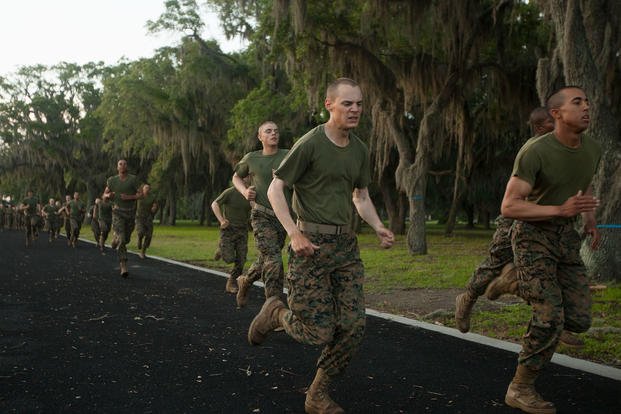You may think that the fitness test you are taking before joining the military is not that important, nor accurately measures your ability as a soldier. That is true. However, such tests are very important in determining a baseline of fitness that will prevent you from a greater chance of failure in training because of musculoskeletal injuries and overuse injuries.
Stew, I understand that you have to train for a fitness test to get into a specific training program and perform at an outstanding level if you want to be competitive, but is there anything I should be doing in addition to training for a fitness test?
Great question. Like you (I am assuming), I do not like to "just train for a fitness test," as there is much more to military training than a fitness test to get through the training. However, when billets to enter programs such as special ops, SWAT, and branches of the military and departments in the law enforcement world are tight, the better you do physically the more competitive you are. Also, with the studies listed below, you can see how important a higher fitness level is to your performance in training and following longevity in active duty. (Related article: See To and Through Article)
Check out the related studies in the Journal of Athletic Training (National Athletic Trainers Association) focused on the military tactical athlete. The same data hold true for law enforcement and firefighting as well. These studies took the performance on the entry fitness test of candidates and observed how they did in training. The studies focused on overall physical performance as well as injury statistics.
Why Being Physically Prepared for Running and Other Activities Is Important
Injured trainees are three times more likely to be discharged before graduation. These injuries typically come from deconditioned candidates who lack posterior chain strength and flexibility (legs, hips, lower back) and a running foundation.
Knee overuse injuries occur throughout the process (training, active duty, reserve units) and are related to weak hips and leg muscles, and lack of a proper progressive running foundation.
Working on your weakness is critical. Depending on your athletic history, you may be an endurance athlete and find that running is easy, but PT, lifting and carrying weight are difficult. The opposite is true to the power/strength athlete who has difficulty running fast for longer distances but easily handles the PT, lifting and carrying exercises. Depending on who you are, you may need to add in (and maintain) your strength, but build on your cardiovascular endurance and your running foundation in a progressive program.
Beginner Running Plan: Overuse injuries happen to beginner runners frequently if they are not prepared with the basics of running.
Advanced/Spec Ops Running Plan: Overuse injuries happen on the high end of the spectrum to even the best athletes with a decent running foundation.
Progressive running plans are needed, no matter what the level of fitness.
Some statistics about military injuries:
- Between 19% and 44% of Army trainees and 12.5% of Air Force trainees sustain a musculoskeletal injury.
- In Army trainees, chronic knee injuries are the most common overuse injury, accounting for up to 44% of all injuries.
- Lateral ankle sprains are the most common type of acute injury.
These types of injuries can be predicted with high accuracy based on a simple fitness test score.
According to the Department of Defense, more than 800,000 military service members are injured each year, leading to an estimated 25 million days of limited duty annually. Most of these injuries are musculoskeletal and affect the lower extremity. They range from minor strains and contusions to major ligament sprains and bone fractures. All of these injuries typically contribute to a lack of readiness, poorer overall fitness and obesity.
Using the standard Army fitness test, the results of the test showed that people with slower run times, fewer push-ups and sit-ups, and who were older were highly susceptible to acute musculoskeletal injuries. Slower run times also were correlated directly with typical overuse injuries (shin splints, knee pain, stress fractures, etc.). Read the details of the study to see the line of fitness that determines success or failure in military training programs.
More related studies on military members, injuries and fitness correlation:
- Risk of Lower Extremity Injury in a Military Cadet Population After a Supervised Injury-Prevention Program
- A Meta-Analysis to Determine if Lower Extremity Muscle Strengthening Should Be Included in Military Knee Overuse Injury-Prevention Programs
- Risk Factors for Injuries During Military Static-Line Airborne Operations: A Systematic Review and Meta-Analysis
This is unrelated to musculoskeletal injuries, but learning a proper way to cool the core temperature when overheated will save a life, maybe your own. There are various methods of cooling the human body, from ice packs on hands, armpits and neck, immersion in water, cool hydration, sweating and more.
Find out below what actually works from these studies:
- Evaluation of 2 Heat-Mitigation Methods in Army Trainees
- Cooling Effectiveness of a Modified Cold-Water Immersion Method After Exercise-Induced Hyperthermia: Important follow-up to above Heat Mitigation Study.
Stew Smith is a former Navy SEAL and fitness author certified as a Strength and Conditioning Specialist (CSCS) with the National Strength and Conditioning Association. Visit his Fitness eBook store if you're looking to start a workout program to create a healthy lifestyle. Send your fitness questions to stew@stewsmith.com.
Want to Learn More About Military Life?
Whether you're thinking of joining the military, looking for fitness and basic training tips, or keeping up with military life and benefits, Military.com has you covered. Subscribe to Military.com to have military news, updates and resources delivered directly to your inbox.



















